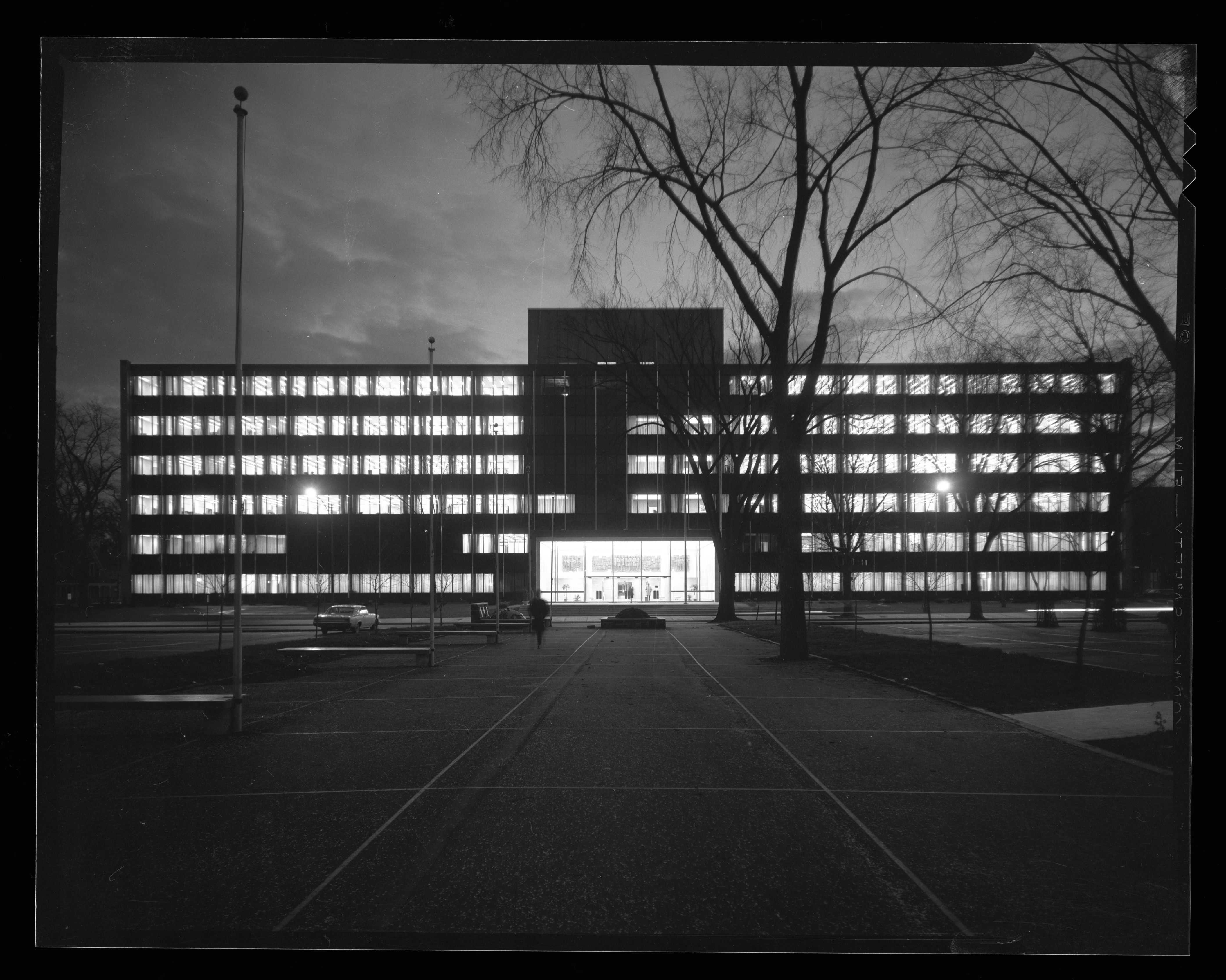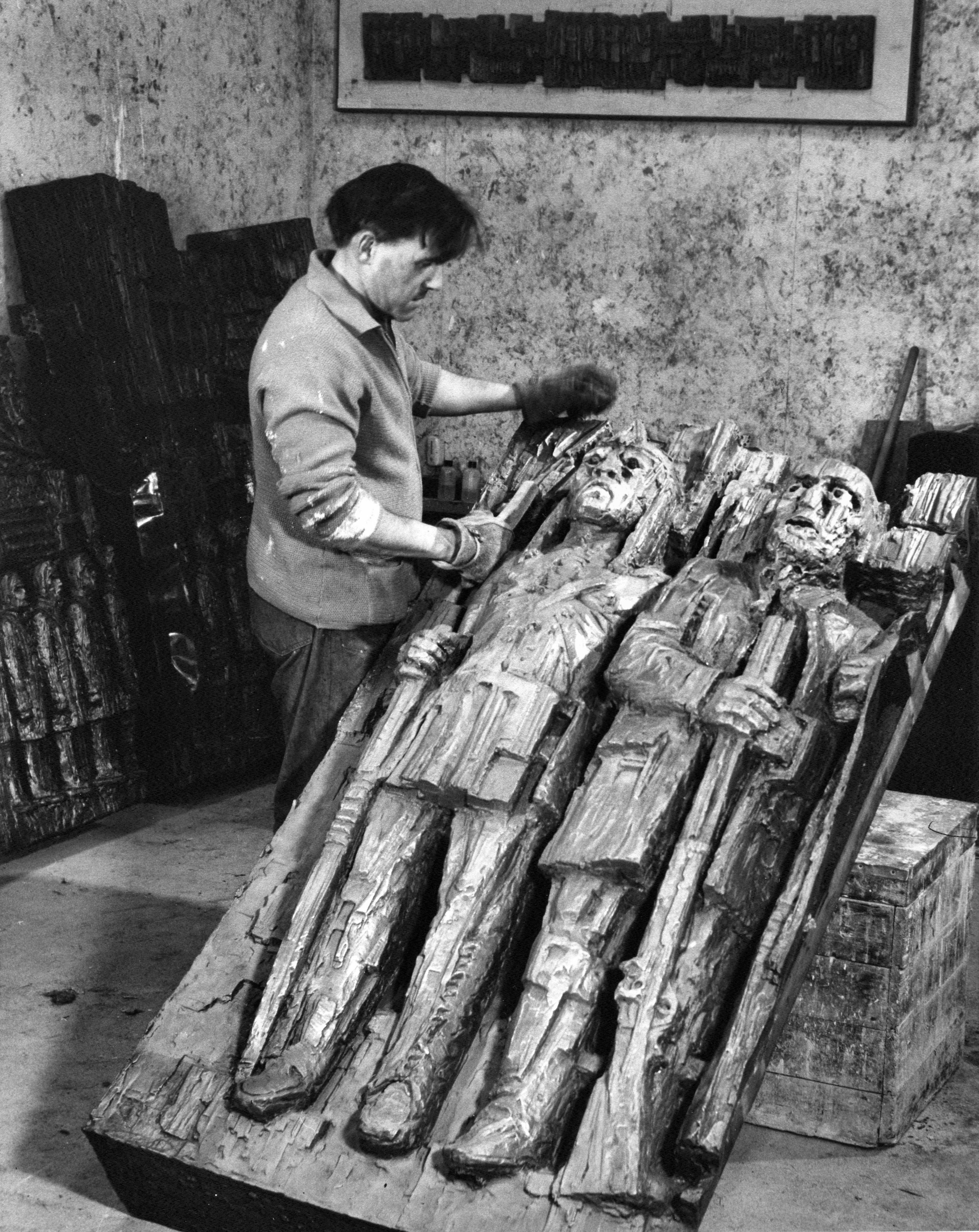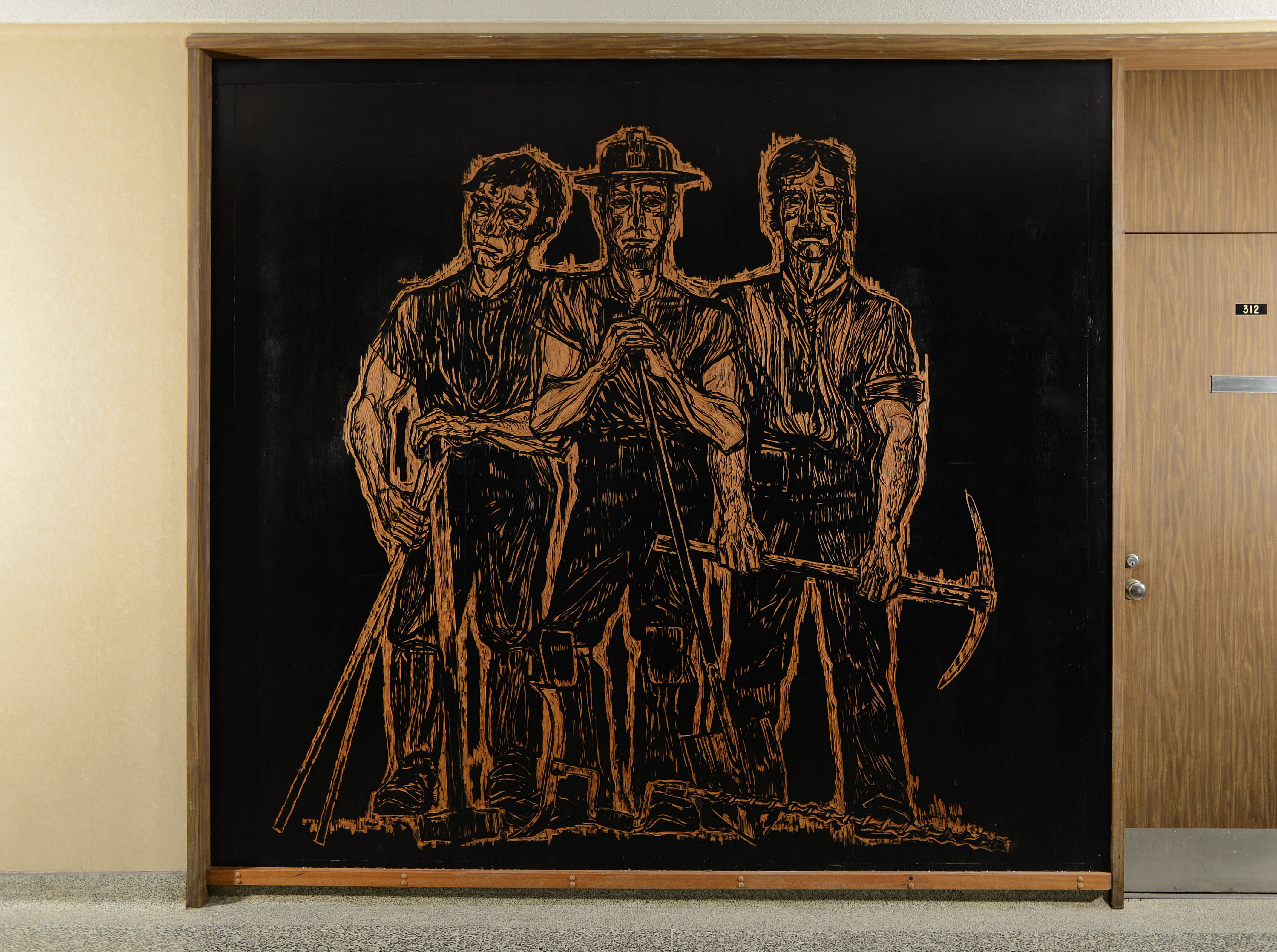December 2, 2020
Jon Pedersen was 20 years old, living in his parents’ basement in Hampton and doing occasional carpentry, when he heard sculptor John Hooper had moved just three doors away.
It was the summer of 1964 and Pedersen knew Hooper had recently won a commission to create a massive public mural.
The mural, along with five other major works of public art by prominent New Brunswick artists, was for the inside of a six-storey building under construction in downtown Fredericton. The building was to house all provincial government offices.
It was to be called the Centennial Building and its opening was set for March 1967, the year of Canada’s 100th birthday.
“The building really represents turning the corner for New Brunswick into the future,” said the now-retired Pedersen, who became an assistant to Hooper on the mural project.

Centennial Year suggested a coming of age for Canada, and the euphoria was felt across the country, according to Robert Pichette, former assistant to former premier Louis Robichaud in Fredericton architect John Leroux’s book 1967.
In New Brunswick, this pride was expressed in the Centennial Building, a structure that would be a symbol of unity, prosperity and modernity for the province.
Or that was the idea.
Now, just a little more than half a century later, and after more than nine years in limbo, the Centennial Building has been sold to a private developer who wants to slice it in half — one-half for a boutique hotel, the other for high-end apartments.
Current plans will see penthouses forming a seventh floor and balconies added to the front façade, a detail that makes Leroux, who has fought for years to protect the building, shudder.
Retail shops and restaurant space will go on the ground floor, where the entrance will be sheltered by an awning.
As for the publicly owned art, it might be easier to break into the Beaverbrook Art Gallery than understand its future.

Among those who care about the artworks, opinion is divided. Some, including Leroux, say it must remain in the building or risk a shattering death if removed.
“They are as much part of the architecture as the granite walls in the front lobby,” said Leroux.
But that would mean New Brunswickers might never again be able to see the art, unless they find someone to buzz them in.
Others, like Julie Whitenect, director of ArtsLink NB, say the art should be rescued and made available to all New Brunswickers, even if it means wrenching it away from its historical role.
Over the past two months, CBC News has tried, without success, to talk to politicians and public servants, at the local and provincial levels, about plans for the building and the art.
Most of them would not speak. People outside government who are directly involved in the project also refused to talk.

The art in the building
In 1964, the government chose six artists to create the works that would bring the building and its significance to life.
“The artists were all given direction by the Robichaud government to build pieces that showed the potential of New Brunswick's future,” said Pedersen.
The six pieces represented different sectors of growth in New Brunswick, including the forestry, mining, fishing and farming industries, and celebrated the province’s literature and history.
- Claude Roussel created a welded steel-rod mural depicting a forest with lumbermen hauling logs.
- Bruno Bobak painted and gauged a plywood mural that shows in chiselled lines three miners.
- Jack Humphrey did a coloured-glass mosaic tile mural of three fishermen walking onshore.
- Tom Forrestall welded a sheet of steel with a patina of farm animals, plants, barns and a tractor.
- Fred Ross painted a circular mural, with almost completely abstract curves. It celebrates New Brunswick writers like Charles G. D. Roberts.
- John Hooper’s large bronze mural relief was inspired the history of the New Brunswick people.

For two years until 1966, Pedersen met Hooper in his garage and helped him create the relief that, built in 13 separate sections, ended up being more than 13 metres long and two metres tall.
From left to right, the mural relief cast in bronze tells the story of New Brunswick, saluting Indigenous peoples, forests, ships, buildings, the Fathers of Confederation and industry.
The mural was installed in the building’s marble lobby facing King Street.
At the centre of government
For more than 40 years, the Centennial Building and the art within it were the centre of the New Brunswick government.
“We waved at the premier as he came every day in his car and parked and went into the building,” said Pedersen, who in 2011 bought a quaint house on St. John Street, with a front porch that sits just a few metres from the Centennial Building’s side door.
The building housed 1,000 employees and cost $7.6 million, of which $2.5 million came from the federal government, under a program that helped provinces pay for new buildings and other structures that celebrated Canada’s 100th birthday.
'I would start describing what it represented. Even the security people in the building would sit and listen.'
The lobby, with its terrazzo floors and marble columns, was used as the Moscow airport in a movie shot in Fredericton about the famous Canada-Soviet hockey series in 1972.
Anyone who visited the building would see the art as soon as they left the elevator, beginning with the Hooper mural in the lobby.
“There were always people there, tourists there, looking at it,” Pedersen said. “I would start describing what it represented. Even the security people in the building would sit and listen.”

'We don't need more government buildings in this province'
As the years went by, the building that represented the future of New Brunswick began to seem like a grubby relic of its past. It used asbestos as insulation, and it had air and water leaks, among other problems.
In 2012, provincial employees slowly moved out, into Chancery Place across the street, with talk of possibly moving back after renovations.
The decision about what to do with the Centennial Building — demolish or renovate — was deferred until a Liberal government adopted a $76 million plan to refurbish it and add a courthouse. In 2018, the Progressive Conservative government put an end to that.
"We don't need more government buildings in this province," Premier Blaine Higgs said at the time.
When Pedersen heard the news, he feared the art would head straight into a black hole and never emerge.
“I guess my fears were well-founded from what I have learned since,” he said. The city is now considering the proposal to turn the Centennial Building into a hotel and apartments after it was sold to Springhill Construction for $4 million, half what it cost to build.
The future that awaits the five pieces of art that will still live in the Centennial Building is described as 'deplorable' by one of the artists, and other advocates in New Brunswick.
Art will remain in the building
The three works of art still in the building have been enclosed in plywood boxes to try to protect them from construction debris: the Hooper mural, the Bobak on the third floor and the Humphrey on the fourth floor.
The Roussel and Forrestall murals were temporarily removed by the New Brunswick Art Bank while work was done on the walls in which they were originally placed.
The sixth piece, by Fred Ross, was lost in the early 1990s during renovations to the sixth floor and never found again.
“I heard that it was stored in the basement of the New Brunswick College of Crafts and Design downtown,” Leroux said. “And somewhere it was probably thrown away thinking it was just pieces of plywood.”
The New Brunswick Art Bank, which owns the art, refused to speak with CBC News.

The Department of Tourism, which oversees the Art Bank, sent an email statement saying the art still in the building will remain, and the pieces taken out will be reinstalled where they once were.
“[The art] will be protected and conserved and will remain a lasting and important element.”
The department provided no explanation as to how the art would be protected and conserved but confirmed the pieces would only be visible to people living or staying in the building.
'How do you incorporate a 10-feet-by-10-feet wall mural of mosaics ... into an apartment hallway?'
This is a great loss for New Brunswickers, according to Pedersen.
“How do you incorporate a 10-feet-by-10-feet wall mural of mosaics, a beautiful coloured mural showing a New Brunswick fishing village, how do you incorporate that into an apartment hallway?” he asked, referring to the Jack Humphrey piece.
“What if somebody has a drunken party and they come out in the middle of the night and decide they’ll take a few tiles off of the Jack Humphrey? You know, take them for souvenirs. You just can’t do that.”

No access to the art, developer says
Despite its history, no provincial heritage protection was applied to the Centennial Building before its sale, which means redevelopment of the site relies entirely on the purchaser, Geoff Colter, owner of Springhill Construction.
Colter would not speak to CBC News.
During a planning advisory committee meeting last month, Pedersen asked him if New Brunswickers would be able to access the art after the building was refurbished.
“I really don't see how you open up a hotel and a private residence to the public just to let people come and go,” Colter said.
But he said the “big piece that is sitting in the ground floor,” referring to the Hooper mural, will be open to members of the public, if they visit the restaurant that, according to the design, will go in that space.

Colter also said art conservators thought it would be “next to impossible” to remove the art that remains in the building.
“So we’re going to do our best to work around them during the course of construction and they’ll stay there.”
Whitenect, of ArtsLink NB, is skeptical of the reasons for not moving the art.
“I would question whether or not they are that fragile, or that difficult to remove,” she said. “I think maybe, perhaps they will be expensive to remove.”
ArtsLink NB sent Premier Higgs a formal letter on Monday, in which it expressed their concern for these pieces. The organization hasn't heard back.
The Premier's office did not respond to CBC's request for an interview.
Whitenect said she wants to hear more from the Art Bank.
“Did they consult the artist or their estates, depending on the situation, to find out if this was OK? This was not the original intent of the works, and there may be some copyright issues around that.”

'Surprised,' 'horrified' and 'disgusted'
At 90 years old, Claude Roussel knows artists can lose control of their work when it’s sold, but he doesn’t like what’s planned for the Centennial Building art.
The Acadian artist spent two years welding in his Dieppe studio to create the mural that has now been taken apart by the Art Bank and stored in two vaults, awaiting a future that was not part of the plan.
Roussel knew his mural was in storage, but he was unaware its reinstallation in the Centennial Building might mean it never again has a public audience.
“I think it’s really deplorable,” he said.
“I don't think we would have a right to stop the transaction, but it would be nice if it would be respected and reinstalled in a forestry building."
CBC News was unable to reach Tom Forrestall. He and Roussel are the only Centennial Building artists still living.

Kathy Hooper, the late John Hooper’s wife, agrees with Roussel.
“I’m really surprised and a bit horrified — disgusted, really,” she said.
“They bought the pieces, as far as I know, under the understanding that they would be in public places. This guy, this developer, has got quite something. He’s got a big and extremely expensive, probably now at least, piece of art in his restaurant and that’s not where it really should have been.”
Hooper said her husband would have been sad, and she doesn’t understand the decision.
“I’m amazed. I thought the Art Bank was a pretty open place. But this is very bad, what they’re doing.”
Artworks monitored, but until when?
The works now boxed in the building are monitored by Michelle Gallinger, an arts conservator based in Halifax who was hired in 2017 by the former Liberal government to assess the murals.
“The boxes have slanted roofs so that [workers] couldn’t put tools on top of them, and if anything actually happened during a demolition or removal, that things would slide off the surface and wouldn’t stay stuck on the top, including water,” said Gallinger.
The boxes also have data loggers, which record the temperature and humidity every hour.
Every week, the data is collected by architects and sent to Gallinger for revision.
But Gallinger doesn’t know how long this monitoring will last.
“I would imagine we are monitoring them until the end of renovations, or when they reinstall the pieces."

‘Would this get my blessing? Obviously not.’
John Feeney of Goguen Architects designed the proposed redevelopment of the Centennial Building.
During the November planning advisory committee meeting, he said he used John Leroux’s 2010 report on the importance of the Centennial Building and the character-defining elements of it as a guideline.
“We really tried to, where possible, maintain elements and reuse materials and retain the character of the building,” Feeney said.
Leroux disagrees and said the design has “severely compromised” many elements.
“I don't necessarily like being quoted as if it’s saying they followed my report. Would this get my blessing? Obviously not. There are some things that really contravene what I did write about.”
For example, Leroux thinks the building should not have balconies on its front, nor windows pierced into the sandstone walls at either end. He also objected to fabric canopies at the entrance, “covering it like a café.”

Leroux said he talked to the developers about this. Their response was that people who will rent these apartments have expectations.
“I’m really distraught by this because I have been working for 15 years to protect this building,” said Leroux.
Although he appreciates the importance of giving the Centennial Building new life, he said aspects of the proposed design must change.
“This particular project needs to be looked at like a jewel and a gem,” Leroux said.
“This is bigger than simply a building in downtown Fredericton. This represented some of the best materials, it was one of the most important buildings ever erected in the history of the province, and it can't just be treated as a regular commercial building that can be retrofitted.”
Still, Leroux remains hopeful.

Ideally, he said, he would sit down with the province and developer and discuss the options for the building, including reining in some parts of the plan.
“They are not even planning on starting work on this for another year anyway,” Leroux said. “There’s time to get this right.”
But Pedersen, who has watched from his front porch as the once-imposing building deteriorated, is not so sure.
“The Centennial Building, it was once a wonderful symbol of the future of New Brunswick and since the Higgs government took over, it’s a dying symbol of the future of the province. I think it’s a pretty good metaphor.”
